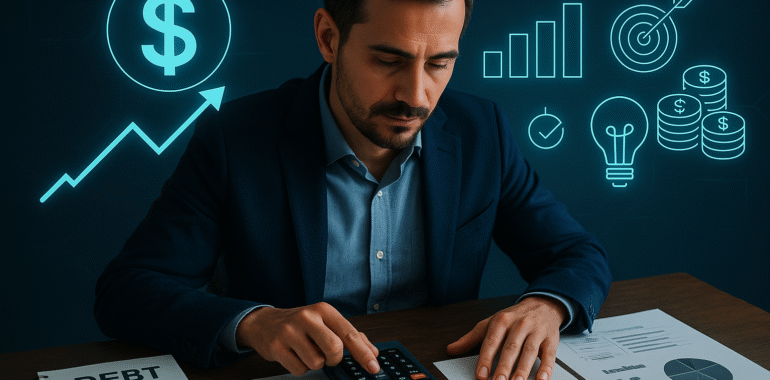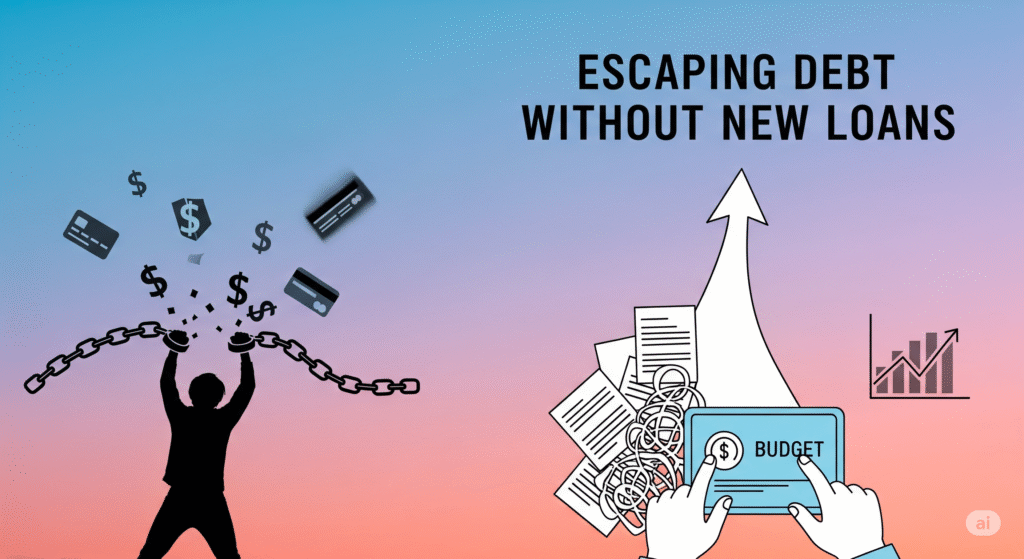Smart Strategies to Get Out of Debt Without Taking New Loans

Smart Strategies to Get Out of Debt Without Taking New Loans
Published in September 2025 | Finance

Escaping debt doesn’t always require more borrowing. In fact, relying on new loans can deepen financial struggles. Fortunately, there are proven methods to eliminate debt without creating new obligations. This guide walks you through practical, sustainable strategies to regain control of your finances—loan-free.
Understanding the Debt Trap
Many Americans fall into the debt cycle unintentionally. Credit cards, student loans, auto loans, and personal financing are accessible, but without careful planning, they accumulate rapidly. Before implementing any strategy, it’s essential to understand your debt landscape and how it affects your financial future.
Table of Contents
- Assess Your Full Debt Picture
- Build a Realistic, Zero-Based Budget
- Prioritize High-Interest Debts
- Find Ways to Increase Your Income
- Cut Unnecessary Spending
- Negotiate with Creditors
- Use the Debt Snowball or Avalanche Method
- Why You Should Avoid New Loans
- Staying Disciplined and Focused
- Build a Debt-Free Financial Future
1. Assess Your Full Debt Picture
The first step is clarity. Gather all loan balances, credit card statements, due dates, interest rates, and minimum payments. Create a spreadsheet or use financial apps like Mint or YNAB to visualize the total amount you owe.
Understanding your financial position helps you make smarter decisions and track your progress effectively.
This content may interest you!
2. Build a Realistic, Zero-Based Budget
A zero-based budget allocates every dollar of your income to a specific category—bills, savings, groceries, or debt repayment—until there’s “zero” unassigned money. This method ensures you’re in control of every dollar and helps reduce unnecessary spending.
Be honest about your expenses and track them weekly. Tools like EveryDollar or simple Google Sheets templates can keep you consistent.
3. Prioritize High-Interest Debts
Debts with high interest rates, such as credit cards, should be targeted first. These accumulate quickly and cost the most over time. Focus on paying more than the minimum monthly payment on these accounts while maintaining minimums on the rest.
Even small increases in payments can lead to major long-term savings.
4. Find Ways to Increase Your Income
Increasing income is often overlooked, but even modest side earnings can accelerate debt reduction. Consider freelance gigs, part-time jobs, selling unused items, or leveraging skills online (like tutoring or virtual assistance).
Use any extra income strictly for debt repayment—don’t let it get absorbed into your lifestyle.
5. Cut Unnecessary Spending

Review your monthly expenses and identify recurring costs you can eliminate or reduce. This includes streaming subscriptions, dining out, impulse purchases, or unused memberships.
Example: Eliminating just three $15 subscriptions can free up $45/month—over $500 annually—for debt payments.
6. Negotiate with Creditors
You may be able to reduce your debt burden without taking new loans by negotiating directly with creditors. Request lower interest rates, ask about hardship programs, or negotiate a lump-sum payoff at a discount.
Many creditors prefer partial recovery over defaults and are open to cooperation when approached respectfully.
You might also like!!!
7. Use the Debt Snowball or Avalanche Method
Snowball method: Focus on paying off your smallest debt first, then roll that payment into the next smallest, creating momentum and motivation.
Avalanche method: Focus on the debt with the highest interest rate first, which saves the most money over time.
Choose the strategy that best suits your psychological and financial preferences—and stay consistent.
8. Why You Should Avoid New Loans
Although debt consolidation loans or balance transfers may seem like solutions, they often extend the repayment timeline and increase total interest paid. Taking on new debt can also reduce your credit score temporarily and reinforce harmful habits.
Focus instead on behavior change and discipline. Long-term results come from new habits, not new loans.
9. Staying Disciplined and Focused
It’s easy to feel overwhelmed. That’s why routines and mindset matter. Set reminders, automate payments when possible, and celebrate milestones (like paying off one card completely).
Debt freedom is not just about money—it’s about regaining peace of mind.
10. Build a Debt-Free Financial Future
Once your debts are paid, redirect those same payments into savings, investments, or emergency funds. This builds financial security and prevents future reliance on credit.
Consider financial literacy as a lifelong goal—read books, take free courses, and continue budgeting even after your debt is gone.
Conclusion
Getting out of debt without taking on new loans is possible—and sustainable. It requires commitment, planning, and consistent action. By following the steps outlined above, you can take control of your financial life and build a stronger, more resilient future.
Remember: you don’t need more debt to fix debt. You need clarity, strategy, and determination.
